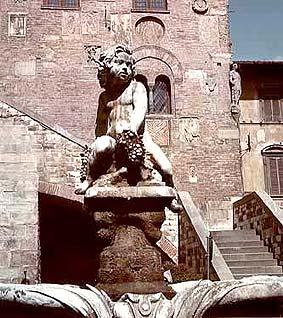


All the structures

Prato, capital of the province since 1992, is of ancient origins. It was populated already in prehistoric times and has a rich Etruscan heritage. It developed during the Middle Ages when it became an important commercial center. Prato is famous in the world for its textile industries.
The cathedral Santo Stefano is a Romanesque building (12th century), enlarged in the 14th century, housing the Pulpito della Sacra Cintola (pulpit, 1434 – 1438) by Donatello, frescoes by Filippo Lippi, Agnoldo Gaddi and Giovanni Pisano. Next to the Cathedral is the Museo dell’Opera del Duomo housing the original bas-reliefs of the pulpit by Donatello, renaissance and medieval plates, artistic things made of gold, miniatures, and a fresco by Paolo Uccello.
In the middle of Piazza del Comune is the Fontana del Bacchini (fountain) created by F. Tacca (1659). To visit the Palazzo del Comune (13th 14th century) and the Palazzo del Pretorio. In the Palazzo del Comune there is the Museo del Tessuto (Museum of the Stuff) with an ancient collection of stuffs; in the Palazzo del Pretorio, made with bricks from ‘200 and enlarged with stones from ‘300, there is the Civic Museum and the Municipally Gallery. Both buildings have been modified during the centuries.
Not far from Piazza del Comune lies the church of San Francesco (1281), with a green and white marble façade, pediment by Giuliano da Sangallo, housing a sepulchral monument by B. Rossellino.
In the Square near by there is the church Santa Maria delle Carceri, a renaissance building by Sangallo (1486 – 95). It has an unfinished façade, and masterworks from A. della Robbia inside. In the same square lies the Castello dell’Imperatore (11th century, enlarged in the first mid of the 13th century by order of Federico II of Swabia). The church of San Domenico has a baroque interior (1283 – 1316), the Museo di Pittura Murale (Museum of mural painting) is in the monastery close by.
In via Della Repubblica a visit must be paid to the Centro per l’Arte Contemporanea Luigi Pecci (a center for modern art).
In the south of Prato there is the city Poggio a Caiano, well known for the villa Medicea (1484) with fresoes by Pontormo, Andrea Del Sarto, Franciabigio.
In Comeana one can visit two Etruscan tombs (7th century b. C.), Artimino is an Etruscan town known for the necropolis of the Prato di Rossello and for its beautiful villa of 1596 – 1600.
In the Bisanzio Valley a visit can be paid to Montemurlo, an ancient village with a church of San Giovanni Decollato and the fortress of the Guidi counts, to Vaiano with the Badia di San Salvatore (church 10th century) and the remains of the fortress of Cerbaia.
Montepiano is a holiday resort, there is the Badia di Santa Maria (church) housing frescoes of the 13th and 14th century.
Who loves nature, should go to the beautiful Tuscan plain Pian della Rosa (1001 m) or to Mt. Buccina (1225 m).